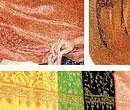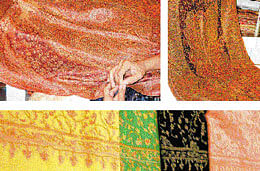

Pashmina refers to a very smooth fabric which is distinctively thin and feather light, mainly used for making shawls, scarves and stoles. One of the most distinguished qualities of this fine fabric, which also accounts for its worldwide popularity, is its extraordinary softness and warmth.
The word pashmina has been derived from the Persian and Urdu word pashm, meaning wool. One of the most admired handicraft items from Kashmir, pashmina shawl is entirely handmade.
Right from the very first step of collecting the wool from special goats, all the succeeding procedures like sorting, spinning, weaving, dying and embroidery, make use of skilled hands. The exceptional craftsmanship which goes in at every level to finish a fine piece of shawl accounts for its expensiveness. The starting price of a pure plain pashmina shawl is 3,000 rupees, which can easily climb up to a couple of lakhs, for an embellished shawl. The kanijamma variety is valued for its highly intricate hand embroidery.
Pashmina weaving first started about 400 years ago in Kashmir. Zain-ul-Abidin, 15th century ruler of the valley, is said to be the person who laid the foundation for traditional cashmere wool industry. The uniqueness of the fabric and its artistic excellence have long captured the admiration of Mughal emperors and Maharajas in India, thus making it an absolute symbol of prestige and pride.
It is said in Ain-I-Akbari (part of Akbarnama, the book of Akbar) that Akbar was so in awe of these shawls that he introduced the unique concept of double weaving, called dushala, which enabled the user to use both sides of the shawl: each side flashing a beautiful embroidered pattern. The information gleaned from the pages of history shows that Mughal rulers patronised the weaving of these shawls and brought much elegance and finesse to the product. The popularity of these shawls also enamoured the nobility in France, the likes of Queen Marie Antoinette. The craftsmen there made efforts to create the magic of pashmina with machines.
To this day, the fascination and fondness for pashmina shawls have not faded out. It continues to catch the eye of the affluent classes.
Coming to the finer details about pashmina shawls, it is the wool which gives these shawls a coveted position and adds much exclusiveness to it. Unlike the ordinary wool, the wool used for making these shawls is extremely light but immensely warm. The wool comes from a special breed of changra or pashmina goat (as they are called) reared in Changthang, a location in Ladakh, north India. These goats are also found in high altitudes of the Himalayas in Nepal and Pakistan.
To counter the extremely harsh and cold weather at a high altitude of 12,000-14,000 ft, nature has gifted these goats with extraordinarily light and warm wool. However, it requires meticulous sorting to get the real pashmina wool, which is just the soft end at the root of the long hair, apt to weave a genuine pashmina shawl.
The height of exclusivity of these shawls could well be fathomed by the fact that it takes at least three goats to produce enough soft wool to weave a single shawl. The pashmina goat is annually sheared in spring and each goat produces less than 80 to 170 grams of wool.
It is believed besides Kashmir, Nepal is emerging as the next noted destination for producing premier quality pashmina shawls. The excellence of wool produced in Nepal is attributed to the merciless climatic conditions of the Himalayas, where the battle for survival, over the centuries, has caused the goats to develop remarkably warm and light coats.
However, the popularity of pashmina shawls is challenged by an array of replicas, available in the market at various costs. Every stole with earthen coloured embroidery and lanky texture may be tagged as pashmina, but in reality, it is not.
Since real pashmina is very light wool, likely to wear off soon, manufactures often blend it with silk to give it strength and sturdiness. The ratio of pashmina wool to silk may vary from 80/20 or 50/50. The use of silk adds durability, as well as gloss, to the product.
Here, it is essential to mention that pashmina shawl may not be confused with Shahtoosh, king of wool; a shawl that passes through a ring. This shawl may boast of fabulous warmth and exceptional light weight, but the government of India banned the sale of Shahtoosh in India around 1977. The wool used for these shawl was collected from a rare Tibetan antelope, called chiru, which would be killed for the purpose of shawl making. To protect the animal species, the ban was enforced along with penalties for those buying or selling Shahtoosh shawls.